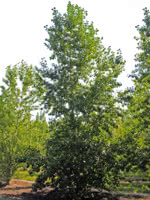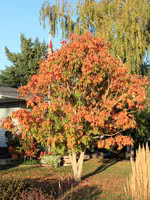Mon-Fri 9am - 5pm Mountain time
Ohio Buckeye vs Tristis Poplar
Populus x Tristis
Aesculus glabra
NOT AVAILABLE THIS SEASON - MIGHT RETURN
Tristis Poplar is a large deciduous tree. It is cold hardy, disease resistant, and relatively drought tolerant. Tristis Poplar loses its leaves later in the year than other Poplars, making it a great ornamental tree in fall.
It's known for its strongly scented balsamic buds and yellow foliage in autumn. Because of its size, Tristis Poplar is most suitable for large properties and will help prevent wind erosion.
Tristis Poplar is slower-growing than many newer hybrids, for a longer useful lifespan. Tristis grows especially well in the southern prairies due to its resistance to cold dry winds.
Ohio Buckeye is a medium sized deciduous tree. If you are looking for a shade tree, Ohio Buckeye's dense canopy of unique leaves can provide it.
Named after its fruit, an inedible nut enclosed in a prickly husk, Ohio Buckeye also features green-yellow flowers and long, broad leaves that turn brilliant red in the fall.
Slow growing, but an extremely attractive tree. Find out what experienced horticulturalists already know: this tree is a gem.
A top CO2 absorbing species. Experts think this tree may help climate change more than others.
Tristis Poplar Quick Facts
Ohio Buckeye Quick Facts
Toxicity: nuts are toxic to humans and cattle
In row spacing: 2.4 m (8 ft)

